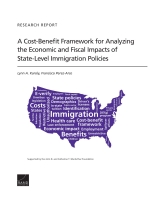| 来源类型 | Research Reports
|
| 规范类型 | 报告
|
| DOI | https://doi.org/10.7249/RR1397
|
| 来源ID | RR-1397-MCF
|
| A Cost-Benefit Framework for Analyzing the Economic and Fiscal Impacts of State-Level Immigration Policies |
| Lynn A. Karoly; Francisco Perez-Arce
|
| 发表日期 | 2016
|
| 出版年 | 2016
|
| 页码 | 118
|
| 语种 | 英语
|
| 结论 |
State-Level Immigration Policies May Produce Impacts in Multiple Domains- State-level immigration-related policies are typically motivated by concerns for the size of the unauthorized immigrant population in a state, competition in the labor market, and the use of public services by unauthorized immigrants, among other impacts of unauthorized immigration.
- Theoretical predictions and empirical findings indicate that, depending on the policy, impacts may be found across the board, from state economic activity to population health and utilization of health care.
Some Expected Effects Have a Clear Direction of Impact; Others Are More Uncertain- In the case of policies that are restrictive toward unauthorized immigrants, the first-order effects for the unauthorized immigrant population are typically unfavorable (i.e., costs exceed benefits) and the reverse holds when policies are unrestrictive.
- Other outcomes, typically second-order effects through changes in labor supply or labor demand, are less certain in terms of their expect net benefits.
- Given these uncertainties in the policy impacts, it is important to undertake empirical research to assess the realized outcomes for unauthorized immigrants and other population groups in states adopting immigration-related policies relative to those that do not.
Expected Effects Often Go Beyond Those for Unauthorized Immigrants to Include Potential Spillover Effects for Other Stakeholders- In each of the policy areas considered, potential impacts were identified for authorized immigrants and natives (including the U.S. citizen children of unauthorized immigrant parents) that were often unintended and theoretically ambiguous in terms of their net effect.
- To the extent that state-level immigration policies also affect state and local governments (or even the federal government), those effects ultimately affect nontargeted populations as taxpayers or recipients of government services.
A Growing Literature Documents the Effects of State-Level Policies But Important Gaps Remain- As the volume of state-level immigration-related policies has expanded, there has been growth in the number of research studies that seek to measure the causal effects of the policies.
- Although few formal cost-benefit analyses of state-level immigration policies have been conducted, they can inform overall economic and fiscal impacts, as well as distributional consequences.
- Predominance of certain state policies may reflect underlying cost-benefit calculations.
|
| 主题 | Immigrants and Emigrants
; Immigration and Emigration
; Immigration Legislation
; Public Sector Governance
|
| URL | https://www.rand.org/pubs/research_reports/RR1397.html
|
| 来源智库 | RAND Corporation (United States)
|
| 引用统计 |
|
| 资源类型 | 智库出版物
|
| 条目标识符 | http://119.78.100.153/handle/2XGU8XDN/108177
|
推荐引用方式
GB/T 7714 |
Lynn A. Karoly,Francisco Perez-Arce. A Cost-Benefit Framework for Analyzing the Economic and Fiscal Impacts of State-Level Immigration Policies. 2016.
|
|
文件名:
|
1495316307267.jpg
|
|
格式:
|
JPEG
|

|
文件名:
|
RAND_RR1397.pdf
|
|
格式:
|
Adobe PDF
|
除非特别说明,本系统中所有内容都受版权保护,并保留所有权利。